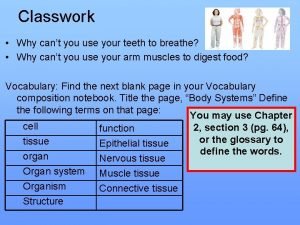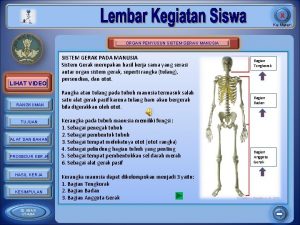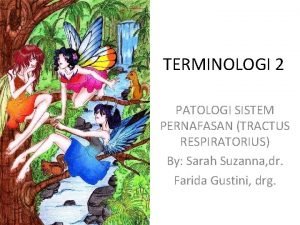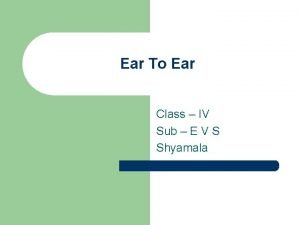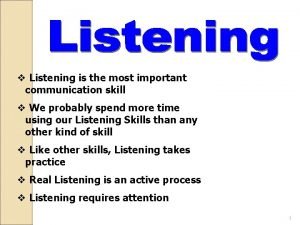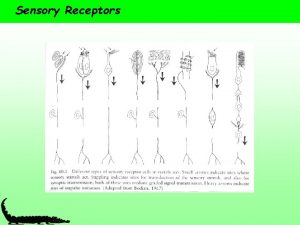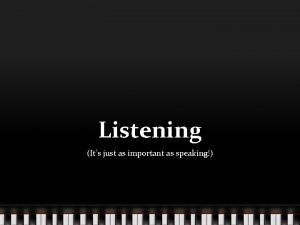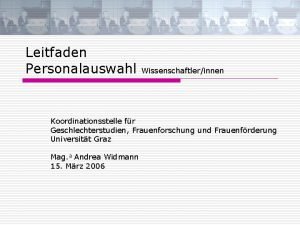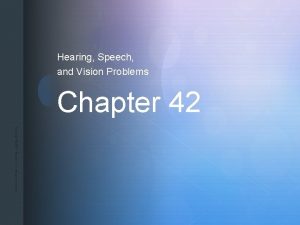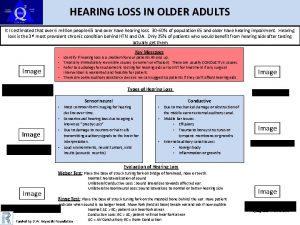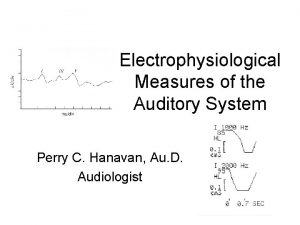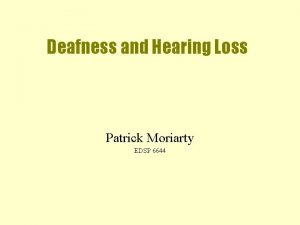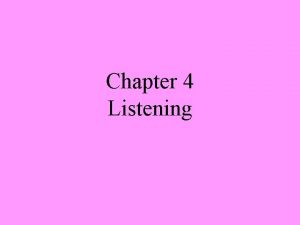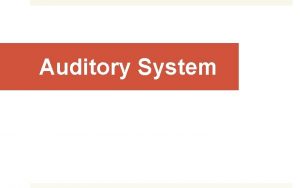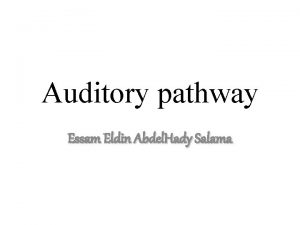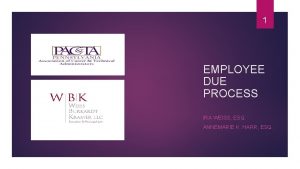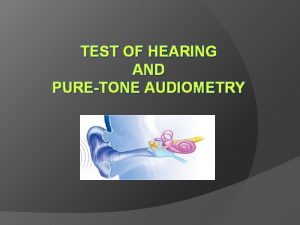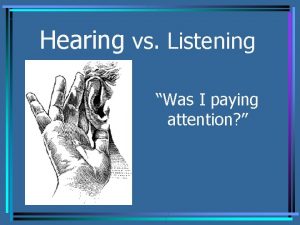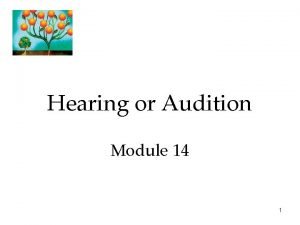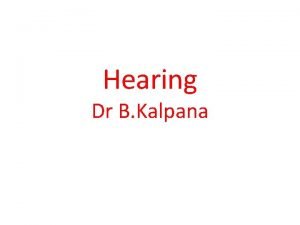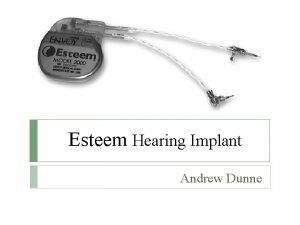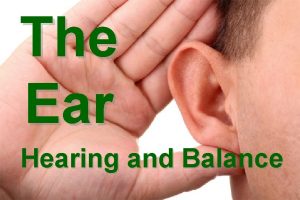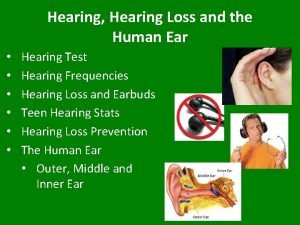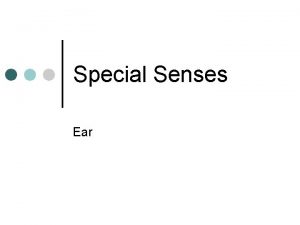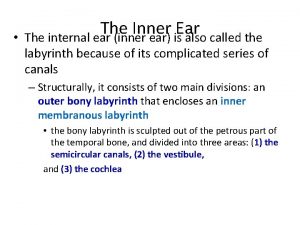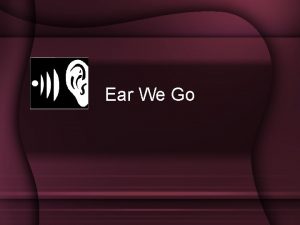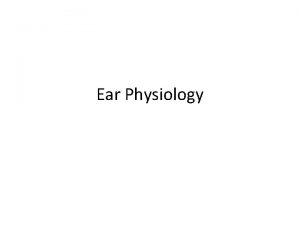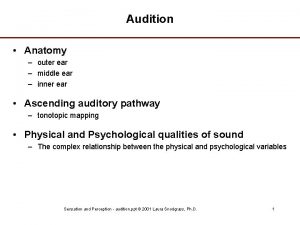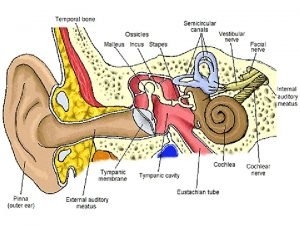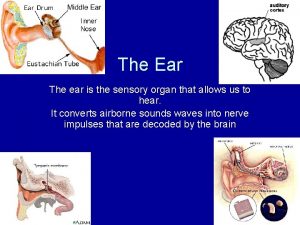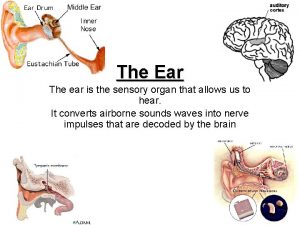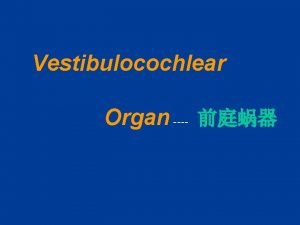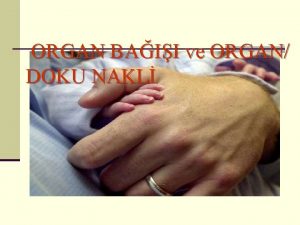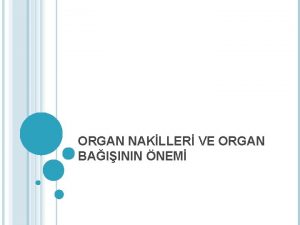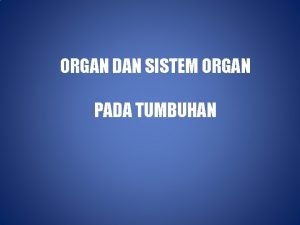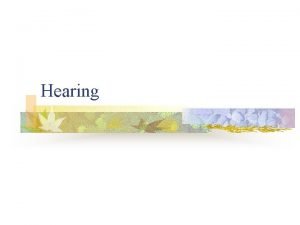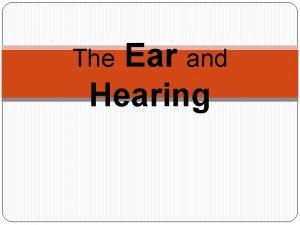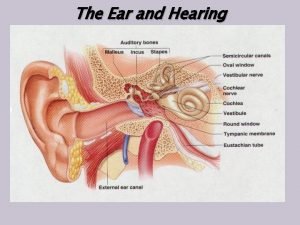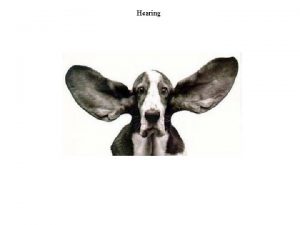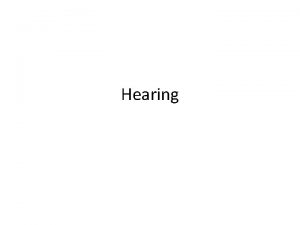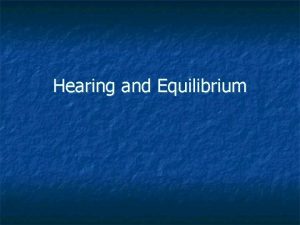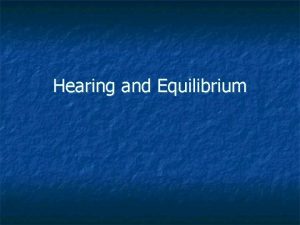EAR THE ORGAN OF HEARING INTRODUCTION The ear













































- Slides: 45

EAR THE ORGAN OF HEARING

INTRODUCTION • The ear is the organ for collection, conduction, modification, amplification and analysis of sound reaching it. It not only receives sound, but also aids in balance and body position. • Ears are responsive to extremes of sound frequencies from 20 to 20, 000 Hz

EAR

PARTS OF EAR • Three parts 1. 2. 3. a) b) External ear: Collect and conduct the sound wave to the tympanic membrane Middle ear: Filled with air, Intensifies the force of sound vibration Internal ear: consists of. Organ of corti- concerned with hearing Vestibule & semicircular duct- concerned with balancing

EXTERNAL EAR

EXTERNAL EAR • Consists of- 1. Auricle ( pinna)Composed of elastic Cartilage covered by skin 2. External acoustic meatus- 2 parts- i. Lateral 1/3 rd-cartilage of pinna ii. Medial 2/3 is bony

PINNA

EXTERNAL EAR • Lobule- It hangs below the anti tragus, no cartilage , skin covers fibro fatty tissue. • External acoustic meatus- lined by true skin. The skin surrounding the external acoustic meatus contains glands that produce wax (cerumen). The ear canal ends at the external surface of the tympanic membrane • Inflammation of this meatus is extreme painful as skin is adherent to the underlying structure.

Middle EAR

MIDDLE EAR • The middle ear is an air-filled cavity between outer & inner ear, contained within the petrous part of temporal bone and separated from external ear by tympanic membrane

BOUNDARIES OF MIDDLE EAR • Roof- is formed by tegmen tympani • Floor – formed by a thin plate of bone separating the cavity From the jugular bulb.

BOUNDARIES OF MIDDLE • Anterior wall – EAR presents canal for tensor tympani muscle, orifice for auditory tube, carotid canal. • Posterior wall – presents aditus to the mastoid antrum and canal for the facial nerve

MIDDLE EAR

BOUNDARIES OF MIDDLE EAR • Medial wall – separates the cavity from the inner ear and presentsv. Promontory – a rounded elevation. v. Fenestra vestibule- lies above and behind the promontory v. Fenesta cochlea - lies below and behind the promontory

BOUNDARIES OF MIDDLE EAR • Lateral wall – is formed entirely by the tympanic membrane or ear drum which receives the sound waves and conduct it to three ossicles as vibration

CONTENTS OF MIDDLE • Three ossicles- EAR malleus, incus and stapes • Muscles- tensor tympani and stapedius • Nerves- facial, Glossopharyngeal, greater and lesser petrosal nerves • Arteries- internal carotid, branch of maxillary, middle meningeal artery • Ligaments • Air

TYMPANIC MEMBRANE • It is a pearly grey oval membrane. • Parts: Malleolar fold divides the membrane into two parts 1. Pars flaccid- small triangular area above the fold, ruptures more 2. Pars tensa- below the fold where handle of the malleus is attached.

STRUCTURE OF TM it has three layers • Outer cuticular layer- lined by keratinize stratified squamous epithelium • Intermediate fibrous- handle of the malleus is attached here • Inner mucous- lined by ciliated columnar epithelium • Surgical Incision of TM is called Myringotomy

TYMPANIC MEMBRANE • Artery supply: - Maxillary artery and posterior auricular artery. • Nerve supply: Auriculo temporal, glossopharyngeal and vagus nerve • Development: • Outer layer- from ectoderm of 1 st brachial cleft • Intermediate layer- from mesoderm of 1 st brachial cleft • Inner layer- from endoderm of 1 st pharyngeal pouch

EAR OSSICLES

EAR OSSICLES • The three ossicles transmit sound from the tympanic membrane to the inner ear. The handle of malleus is connected to the tympanic membrane. The incus is the bridge between the malleus and stapes. The stapes connects to the oval window by its footplate. The ossicles help in amplification of sound waves by nearly thirty times.

MUSCLES OF MIDDLE EAR • The movement of the ossicles is stiffened by two muscles. 1. The stapedius muscle, is connected to the stapes; 2. The tensor tympani muscle is connected to the base of the malleus. These muscles exert damping effect of sound vibration to protect the inner ear from loud sounds.

MASTOID ANTRUM The mastoid antrum is an air space in the petrous part and communicating posteriorly with the mastoid air cells and anteriorly with the middle ear. These air spaces function as sound receptor; provide voice resonance, acts as acoustic insulation. The mastoid air cell system is a major contributor to middle ear inflammatory diseases.


INNER EAR

INTRODUCTION • The inner ear consists of an outer bony and inner membranous labyrinths. This contains the sensory organs for balance and motion, namely the vestibules of the ear (utricle and saccule), and the semicircular canals. This also contains the sensory organ for hearing, the cochlea.

INNER EAR- at a glance Bony labyrinth Membranous labyrinth Function Cochlear duct Contains organ of corti vestibule Saccule & utricle Concerned with static equilibrium Semicircular canal Semicircular duct Concerned with kinetic equilibrium

BONY AND MEMBRANOUS LABYRINTH

COCHLEA • The cochlea is conical in shape, resembles of a common snail. Its apex known copula and directed forward and base lies posteriorly at the bottom of the internal acoustic meatus. The cochlear canal is arranged spirally.


COCHLEAR DUCT • Cochlear duct is the membranous labyrinth within bony spiral cochlea. Inside, from the wall of cochlea two membrane arise vestibular & basilar membrane divides the cochlea into • 1. scala vestibule 2. cochlear duct 3. scala tympany v Two scala contain perilymph and cochlear duct contain endolymph.

COCHLEAR DUCT

COCHLEAR DUCT



VESTIBULE- SACCULE & UTRICLE & SSEMICIRCULAR CANAL - DUCT • Vestibule intervenes between the cochlea in front and semicircular canal behind. By an oblique ridge it is divided into two areas which lodges saccule and utricle • 5 Semicircular canal contains Semicircular duct

SPIRAL ORGAN OF CORTI • It contains special auditory receptors , rest on basilar membrane of cochlear duct. Organ of corti contains hair cells, which respond to different sound frequency. The most characteristic feature of hair cells is the presence of array of sterocilia. The afferent fibers of cochlear nerve come in direct synaptic contact with the hair cells. Between these cells following supporting cells are found: – Pillar (rod) cells, Deiter’s cells and Hensen’s cells

SPIRAL ORGAN OF CORTI


TRACING OF THE SOUND WAVE




INTERNAL ACOUSTIC MEATUS SHOWING THE NERVES

THANK YOU
 Cell tissue organ organ system organism
Cell tissue organ organ system organism Tissue are grouped together to form various
Tissue are grouped together to form various Organ penyusun sistem gerak pada manusia yaitu
Organ penyusun sistem gerak pada manusia yaitu Organ and organ system
Organ and organ system Tractus respiratorius
Tractus respiratorius Sistem koordinasi
Sistem koordinasi Pictures of animals whose ears cannot be seen
Pictures of animals whose ears cannot be seen Different types of ears of animals
Different types of ears of animals Types of reflective listening
Types of reflective listening Barriers to communication
Barriers to communication Listening vs hearing
Listening vs hearing Sensory receptors in vertebrates
Sensory receptors in vertebrates Exposition of romeo and juliet
Exposition of romeo and juliet Hearing on advisement
Hearing on advisement Listening vs hearing
Listening vs hearing Hearing personalauswahl
Hearing personalauswahl Asl if only i could fly
Asl if only i could fly Kode icd 10 otomycosis
Kode icd 10 otomycosis Safetymri
Safetymri Hearing vs listening
Hearing vs listening Chapter 42 hearing speech and vision problems
Chapter 42 hearing speech and vision problems Cookie bite hearing loss
Cookie bite hearing loss Conductive hearing loss lateralization
Conductive hearing loss lateralization Tympanogram as type
Tympanogram as type Ewc hearing outcomes
Ewc hearing outcomes Noah hearing aid
Noah hearing aid Hearing impairment meaning
Hearing impairment meaning Rinne test
Rinne test The receptors for hearing are the
The receptors for hearing are the Active listening vs hearing
Active listening vs hearing Listening vs hearing
Listening vs hearing Loudermill hearing
Loudermill hearing Public hearing for environmental clearance
Public hearing for environmental clearance Hearing neural pathway
Hearing neural pathway Ascending auditory pathway
Ascending auditory pathway Hearing itinerant service rubric
Hearing itinerant service rubric Loudermill hearing
Loudermill hearing Who global estimates on prevalence of hearing loss 2020
Who global estimates on prevalence of hearing loss 2020 Who global estimates on prevalence of hearing loss 2020
Who global estimates on prevalence of hearing loss 2020 Audiogram hearing loss
Audiogram hearing loss Arbitration hearing
Arbitration hearing Factual distractions example
Factual distractions example Place theory
Place theory Theories of hearing
Theories of hearing Hearing aids picture
Hearing aids picture Esteem implant
Esteem implant
